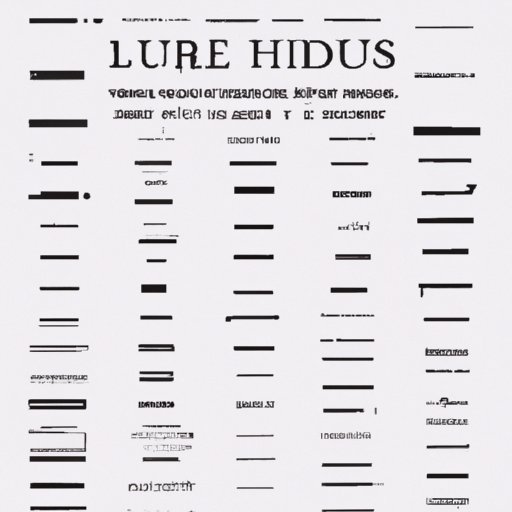Introduction
Dashes are a powerful punctuation mark that can be used to add flair to your writing. They provide a strong visual break between thoughts and ideas, allowing you to emphasize certain points or draw attention to specific words. But knowing when to use dashes in writing can be confusing. In this article, we’ll explore the different types of dashes used in writing, when to use them for maximum effect, and tips for incorporating them into your writing style.

Exploring the Different Types of Dashes Used in Writing
The most common types of dashes used in writing are the em dash, en dash, and hyphen.
Em Dash
An em dash is the longest of the three dashes and is used to indicate a sudden break in thought or sentence structure. It is often used to introduce an explanation or qualification, or to set off a parenthetical statement.
En Dash
The en dash is slightly shorter than the em dash and is used to indicate a range of values or connections between two words or phrases. For example, it can be used to show a connection between two years (e.g., 2015–2016) or between two states (e.g., California–Oregon).
Hyphen
The hyphen is the shortest of the three dashes and is used to link words or parts of words together. It is also used to separate syllables within a word or to divide numbers or letters at the end of a line.
An Overview of When to Use Dashes for Maximum Effect
Now that you know the different types of dashes used in writing, let’s look at when to use them for maximum effect.
To Break Up Sentences
Dashes can be used to break up long sentences or to separate related but distinct ideas. For example, instead of saying “She was a talented singer and dancer,” you might say “She was a talented—albeit underrated—singer and dancer.” This emphasizes the fact that she was underrated without having to repeat the word.
To Connect or Contrast Ideas
Dashes can also be used to connect two ideas or to contrast them. For example, you might say “Her performance was both impressive—and entertaining.” This allows you to emphasize the two qualities at once.
To Create Parenthetical Statements
Finally, dashes can be used to create parenthetical statements. These statements provide additional information about the topic at hand without interrupting the flow of the sentence. For example, you might say “Her voice—rich and powerful—filled the room.” The parenthetical statement emphasizes the qualities of her voice without taking away from the main point of the sentence.

A Guide to Using Dashes for Emphasis and Clarity
Using dashes correctly can help you create sentences that are clear and effective. Here are some tips for using dashes for emphasis and clarity.
Using Dashes for Emphasis
Dashes can be used to emphasize a point or idea. For example, you might say “He was a genius—but no one knew it.” This emphasizes the fact that he was a genius even though no one recognized it.
Adding Variety to Your Writing with Dashes
Using too many dashes can make your writing seem cluttered and disorganized. To avoid this, try to vary the types of dashes you use. For example, if you use an em dash in one sentence, try using an en dash in the next. This will help keep your writing organized and make it more interesting to read.

Tips for Incorporating Dashes into Your Writing Style
Incorporating dashes into your writing style can take some practice. Here are some tips to help you get started.
Read Your Writing Aloud
Reading your writing aloud can help you identify areas where dashes can be used for emphasis. As you read, pay attention to where your voice changes or pauses. These pauses can be used to add dashes for emphasis.
Follow Grammar Rules
It’s important to follow grammar rules when using dashes. For example, never use a dash to replace a comma or semicolon. Also, be sure to use spaces around the dash so it’s easier to read.
Crafting Sentences with the Right Dash: A Step-by-Step Guide
Crafting sentences with the right dash can be tricky. Here’s a step-by-step guide to help you get started.
Identify the Type of Dash You Need
First, identify the type of dash you need. Is it an em dash, en dash, or hyphen? Each type of dash has its own purpose, so be sure to choose the right one for the job.
Choose the Correct Punctuation
Once you’ve identified the type of dash you need, choose the correct punctuation. Be sure to use spaces around the dash so it’s easier to read.
Double Check Your Work
Finally, double check your work to make sure the dash is used correctly. Reading your writing aloud can help you identify any mistakes.
Conclusion
Dashes are a powerful punctuation mark that can be used to add emphasis and clarity to your writing. Knowing when to use dashes and which type of dash to use can help you craft sentences that are clear and effective. By following the tips outlined in this article, you’ll be able to incorporate dashes into your writing style with ease.
In summary, there are three types of dashes used in writing: the em dash, en dash, and hyphen. Dashes can be used to break up long sentences, to connect or contrast ideas, and to create parenthetical statements. When using dashes, be sure to read your writing aloud and follow grammar rules. With practice, you’ll be able to craft sentences with the right dash for maximum effect.
(Note: Is this article not meeting your expectations? Do you have knowledge or insights to share? Unlock new opportunities and expand your reach by joining our authors team. Click Registration to join us and share your expertise with our readers.)
